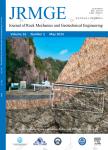Stone column settlement performance in structured anisotropic clays:the influence of creep
Stone column settlement performance in structured anisotropic clays:the influence of creep作者机构:College of Engineering and InformaticsNational University of Ireland Department of Civil and Environmental EngineeringChalmers University of Technology Computational Geomechanics DivisionNorwegian Geotechnical Institute
出 版 物:《Journal of Rock Mechanics and Geotechnical Engineering》 (岩石力学与岩土工程学报(英文版))
年 卷 期:2016年第8卷第5期
页 面:672-688页
核心收录:
学科分类:081401[工学-岩土工程] 08[工学] 0814[工学-土木工程] 080102[工学-固体力学] 0801[工学-力学(可授工学、理学学位)]
基 金:the funding provided by the Irish Research Council(IRC) for the research into stone column behaviour in creep-prone soils part of CREEP(Creep of Geomaterials,PIAP-GA-2011-286397) project supported by the European Community through the programme Marie Curie Industry-Academia Partnerships and Pathways(IAPP) under the 7th Framework Programme The support from the BIG(Better Interaction in Geotechnics) project from the Swedish Transport Administration
主 题:Stone columns Creep Anisotropy Destructuration Finite element (FE) method
摘 要:The recently developed elasto-viscoplastic Creep-SCLAY1S model has been used in conjunction with PLAXIS 2D to investigate the effectiveness of vibro-replacement in a creep-prone clay. The Creep-SCLAY1S model accounts for anisotropy, bonding, and destructuration, and uses the concept of a constant rate of viscoplastic multiplier to calculate creep strain rate. A comparison of settlement improvement factors with and without creep indicates that ‘total’ settlement improvement factors (primary plus creep) are lower than their ‘primary’ counterparts (primary settlement only). The lowest settlement improvement factors arise for analyses incorporating the effect of bonding and destructuration. Examination of the variations of vertical stress with time and depth has indicated that vertical stress is transferred from the soil to the column as the soil creeps. This results in additional column yielding. In addition, the radial and hoop stresses in the soil are lower for the ‘creep’ case. The reduced radial stresses lead to additional column bulging and hence more settlement, whereas the hoop stress reductions appear to be a secondary effect, caused by additional plastic deformation for the ‘creep’ case.



